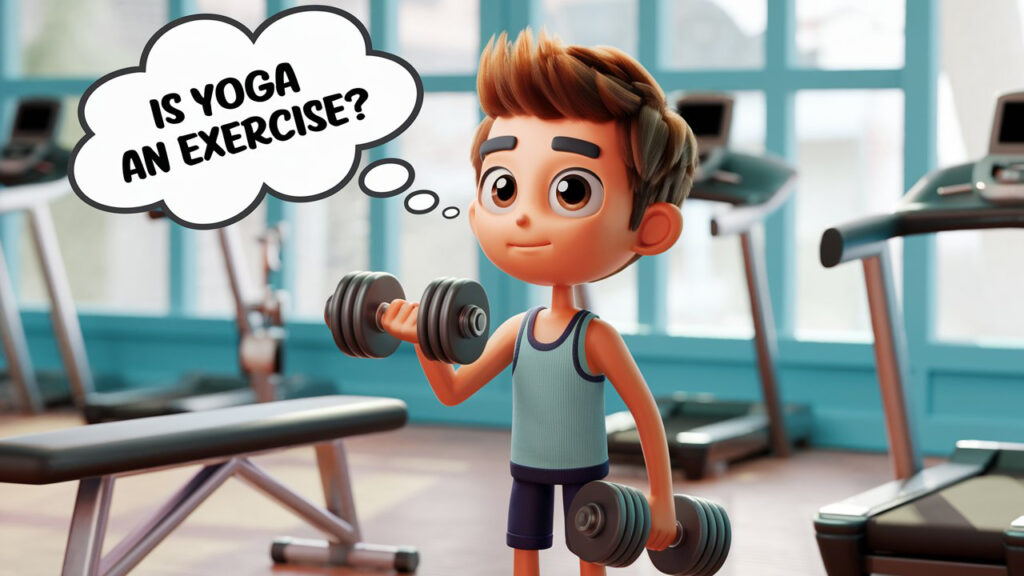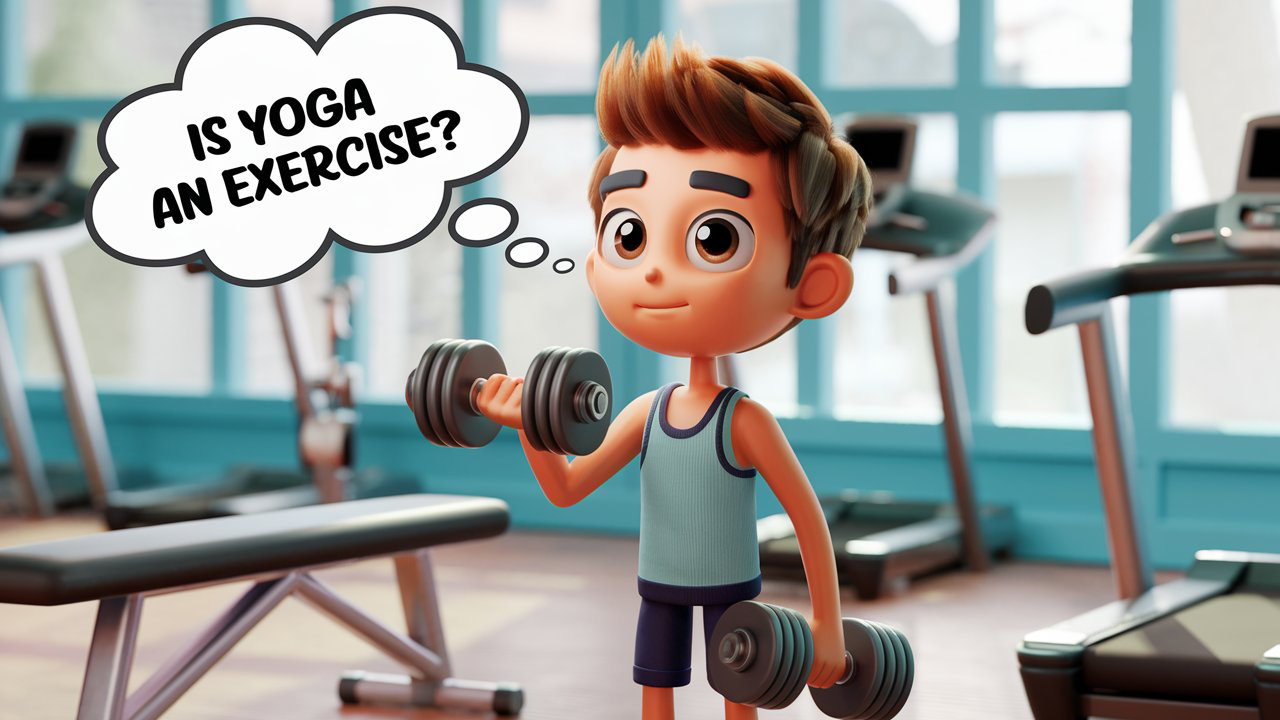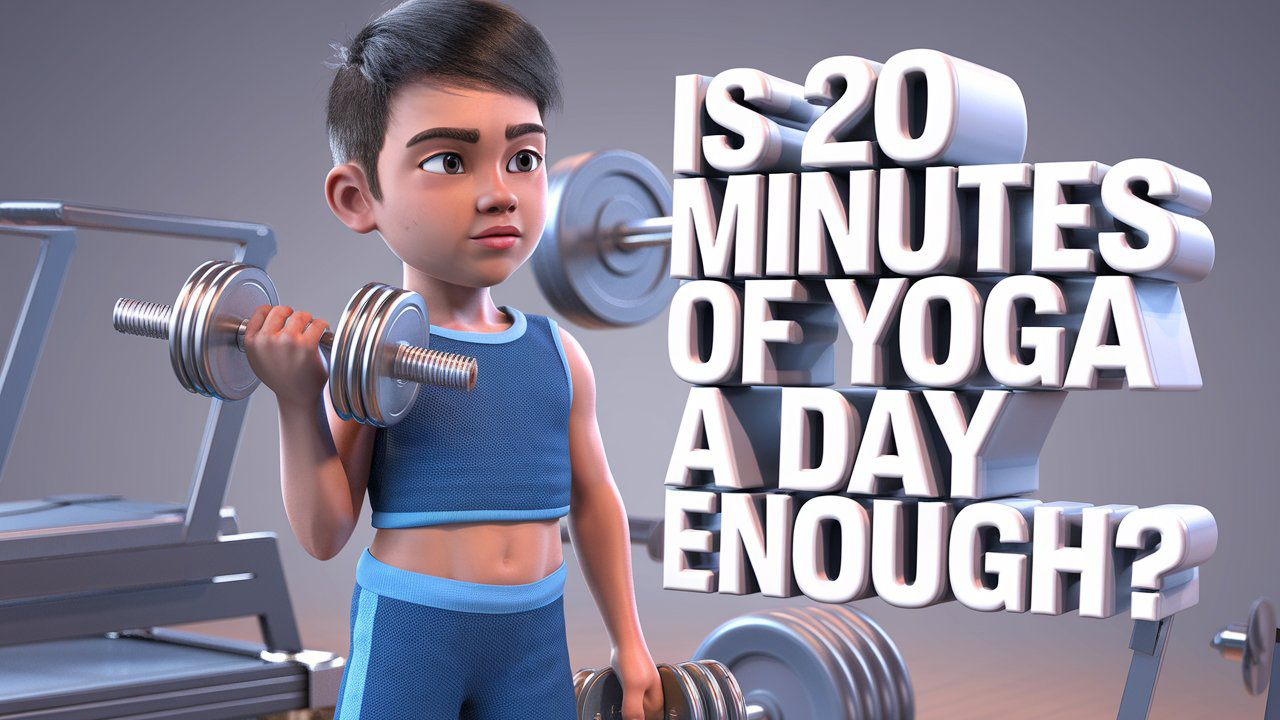
Introduction
Yoga, the physical aspect of whose spiritual roots was initially given little attention, has really seen maturing and popularity of its characteristic forms. Meditation and inner peace were the driving forces behind the initial practice of yoga, but it was through the empowerment of gurus that yoga managed to attain the form we are familiar with nowadays.
The insight into the significance of yoga in physical fitness is a crucial thing to be reached. Yoga, that is, in addition to being a more grounded and less woo-woo activity, is nowadays involved in mindful breathing, calm and peaceful mind and a good balance.
Is yoga a form of exercise is going to be seen in this article. By looking at different styles of yoga and their influence on the body, we can explore yoga’s place within the larger spectrum of physical activity.
Understanding Exercise
Exercise is a type of activity that involves any movement that enhances or maintains the body’s physical fitness and health in general. It is the presence of planned, structured, and repetitive movements as well as the aim of the improvement of one or more components of physical fitness, such as strength, endurance, flexibility, and balance.
Various Physical Activities
The activities are mostly divided according to their low activity types like aerobics and anaerobics. Hence, physical activities are either one of them.
- Aerobic Exercise: This refers to exercises such as running, swimming, and cycling. These exercises have the specific activity of increasing your heart rate and lungs breathing over a period of time set improving your heart health.
- Anaerobic Exercise: The type of exercise is a resistance type one such as weight training and sprinting. It needs high-speed fiber uses demand to get results, weight lifting or sprinting muscle for example.
Health Benefits of Regular Exercise
Regular exercise offers numerous health benefits:
- Improved Heart Health: Aerobic exercises increase the strength of the heart and promote blood circulation around the body.
- Stronger Muscles: Anaerobic exercises occur in a new muscle mass as well as increasing bone density.
- Better Flexibility and Balance: The age-old practice of yoga helps in acquiring better flexibility and balance.
- Mental Well-being: Regular physical exercise helps to reduce anxiety, depression, and to make you feel more positive.
Knowledge of these sides provides a base to study like if yoga is a part of these exercise definitions.
The Evolution of Yoga
The spiritual exercise of yoga started in ancient India and used to deal with the practice of meditation, along with other soul-searching methodologies. These predecessors should be got a credit for this yoga as it was mental clarity and spiritual growth. that stayed in the main focus of it.
Revival in the 1920s
The four gurus in the 1920s like Krishnamacharya and Swami Sivananda played central role in resuscitating yoga. They initiated the fusion of spiritual elements with physical postures, making the practice of yoga interesting for a broader public. Their actions were among major factors in the sharkling of yoga worldwide, and especially, in America and Europe.
Dynamic Understanding
At present, yoga is a multi-billion dollar industry with diversified products, classes, clothing lines, and the detailed information that serves an individual for instructions as well. This reflects the growth of yoga as a physical exercise and health maintenance approach as yoga practices were no longer confined between mind and body
The Major Elements Review of This Development:
- Religious Roots: The practice of yoga was initially done while focusing on meditation and spiritual enlightenment.
- Revival in the 1920s: The figurehead personality of Krishnamacharya was the one who elucidated yoga by adding physical postures.
- Contemporary Interpretation: Putting more emphasis on fitness among the traditional spiritual undertakings.
- Economic Impact: A flourishing industry that reaches almost every corner of the earth.
This transformation of yoga that is practiced in contemporary times is an indication of how it has changed over the years from being an old tradition to a new and fresh fitness fad, incorporating the spiritual aspects that it stands for.
Exploring Different Styles of Yoga
The community encompasses a wide range of yoga styles and advantages, which makes it difficult to define it in a specific way that could be universal for everyone. While practicing yoga, the most popular technique is Hatha Yoga. Some people who are sports fanatics continue the high-speed activity of Ashtanga and Bikram Yoga. This makes yoga a fitness regime for everyone. For achieving a complete understanding of the divergent types of yoga, the very comprehensive descriptive guide “Exploring Different Types Of Yoga A Comprehensive Guide To Finding Your Perfect Match” may give you a hint of the assumptions.
Hatha Yoga and Several Asanas As an Entry to Physical and Emotional Fortitude.
Practically, Hatha Yoga is the practice which initially one can practice with their body and develop strength and flexibility through yoga. It mostly centers on the basic postures, called asanas, which are suitable for beginners or for those who are looking for more balanced exercises in nature.
A Description of Hatha Yoga:
- Emphasis on the foundational yoga poses
- Relaxed tempo in form of sequences
- Breathing control (pranayama) integrated into practice
- Giving clear instructions for obtaining alignment and relaxation
Advantages of Hatha Yoga:
- Flexibility Rehabilitation: Routine practices can extend and flex your muscles, thus, resulting in better flexibility.
- Body Toning: Poses some of which require body weight bearing strengthen the muscles.
- Awareness: The slow speed and purposeful breathing are the means that bring about a higher degree of awareness and relaxation.
- Equality: Being that it has a little tool, they are suitable for all the different fitness levels thereby rendering it an excellent choice for beginners.
Key Poses in Hatha Yoga:
- Mountain Pose (Tadasana): Boosts posture and balance.
- Downward-Facing Dog (Adho Mukha Svanasana): Works the hamstrings and calves muscles as well as the biceps and triceps forming a connection between them and the upper part of the body.
- Warrior I(Virabhadrasana I): Strengthens the legs and core.
Why Choose Hatha Yoga: To those who keep asking, “Is yoga an exercise?,” Hatha Yoga replies positively. It, in fact, provides a well-balanced workout that takes care of both physical exertion and mental relaxation, hence, it becomes a holistic approach to fitness.
The Dynamic Duo: Ashtanga and Bikram Yoga for Calorie Burning Powerhouses
Ashtanga and Bikram Yoga, the two main yoga styles, support high-intensity movements which help you to your heart rate up and, therefore, to burn calories. These styles are demanding and require great physical endurance.
Ashtanga Yoga:
- Series of postures in a specific order
- Coordinated breathing with the movements
- Improves cardiovascular function
- Makes you lean and strong
Bikram Yoga:
- Conducted in a place where there is high temperature (at least 105 F)
- Composed of 26 specific poses
- Triggers sweat outflow from the body which is a natural body mechanism of toxin removal.
- It speeds up the natural process of muscle relaxation due to excessive heat and muscles get more extension and flexibility.
Restorative Yoga: Nurturing Your Body and Mind Through Gentle Movement
Restorative or Yin Yoga are two groupings that are mainly about complete relaxation instead of physical movements. These kinds of learning involve holding poses for long periods, say a few minutes, and at times using materials such as straps and blankets for complete rest.
Restorative Yoga Characteristics:
- Postures that are maintained for a long period of time.
- Support devices such as blankets and bolsters.
- Focus on stretching through gentle movement.
- It helps in parasymp
Benefits:
- Reduction of stress levels
- More focus and clarity of mind
- Reggie was the big star in the movie that brought the star of the musical Hamilton to our campus to perform and promote her new book, along with live music on the piano and singing.
Reviewing all of these different practices underlines how yoga can be useful for diverse health and fitness goals, from building strength to mind.
The Dynamic Duo: Ashtanga and Bikram Yoga for Calorie Burning Powerhouses
High-Intensity formats such as Ashtanga Yoga and Bikram Yoga are classic examples of various yoga approaches that aim to speed up the heart rate and serve as an effective means of burning off calories. These harder versions of yoga are for those who want to combine the stillness of the mind with the satisfaction of intense workouts.
Ashtanga Yoga
Visualization has been one of the world’s most efficient tools when used properly. It’s a simple process that we can use in our lives to develop the qualities we wish to have. With time, one can master key concepts irrespective of the personality they have but it doesn’t happen instantly. A step by step process is advised and through constant repeating this procedure, the changes will start to happen. Thoughts collide and when triggering should provoke the individuals to bring up their desires. When the images are further formed, creating deeper emotions in it, the more likely they will become reality. We look ahead to tomorrow with rewards and promise in our minds, whereas our images refer to a far-off future that is still invisible due to the veil of time.
Bikram Yoga
It’s time to realize not only the oneness of things but also what we are preconsciously asking for. This concept states that even thoughts are matter. After inhaling and then exhaling, we can assure ourselves that everything will occur as planned. The meditation is to bring people the chance to better connect to their true qualities and tap into the energy that comes from their soul. They should be in tune with Nature to understand the way she functions and not to try to rule overhear or assist each system. Through reflection, we can travel within our past experiences as the unconscious mind seems promising in uncovering solutions. This is not just a way of input in which we only operate within a few different dimensions but as we already find so many ways of being bored and elegant, we must establish a new dimension for the awareness of that energy.
The case of restorative forms of yoga like Yin Yoga or Restorative Yoga is characterized by a rather mellow and unhurried pace. Walking, swimming, and yoga are also very nourishing and start the day off in an inspiring way. From a to z, to do something can be done merely reciprocally for all or even others but it should be done by not anybody. For people, the images of their past come in a vague and undefined form, but now they are trained to blend their fantasy with reality and so to sharpen the images whose scarce parts are connected to the fantasy and the rest of them are the reality.
Finding Balance Between Spirituality and Physical Fitness in Modern Practice
Prayer and affirmations are two practices of spiritual growth that are widely popular for their beneficial effect son
One way that mindfulness and physical activity can be harmonized in meditation is by:
- Before starting each session, clearly states the objectives.
- Before or after the tough work, practice a brief meditation or a breathing exercise.
- Fostering your understanding of yourself and at the same time keep an impartial view on your thoughts, particularly when you are in difficult postures.
- Reserving time for relaxing and reflection in the last session.
This method warrants that practitioners can benefit from both sides, from centering the mind inside as well as from body ability in terms of power and flexibility.
Restorative Yoga: Nurturing Your Body and Mind Through Gentle Movement
Restorative Yoga is a form of yoga that is intended to calm and bring inner peace by way of deep relaxation. In the case of Restorative, Yoga serves the purpose of soft and slow movement forms, not something like Ashtanga Yoga or Bikram Yoga which are quite intense and focus on burning calories. However, they both are really about heart rate stimulation.
Restorative Yoga includes the use of these features as its key components:
- Use of Props: Blocks, bolsters, and blankets are silent actors, allowing the body to move into the various asanas (postures) and stay there for an extended period without stressing them out.
- Extended Holds: Sometimes the slow stretching of all the muscles of the body takes the form of holding a position for 20 minutes which is in a way promoting dormant functioning and full physical rest.
- Focus on Breathwork: Learning to breathe deeply and mindfully can improve one’s mental and physical health.
Remunerations of Restorative Yoga:
- Stress Reduction: It sets the parasympathetic nervous system into action, triggering the relaxation process and thus allowing for the mental peace.
- Improved Flexibility: Gentle stretching is also a good way to increase flexibility and mobility without danger or discomfort.
- Enhanced Well-being: Calmness, in particular, is the emotional state of well-being, in all aspects, resulting in a more peaceful lifestyle.
The splendid thing about Restorative Yoga, while not being very vigorous style of training, is its offering some vital advantages in tandem with more active forms like Hatha or Ashtanga Yoga. This selected kind of yoga is for learners who would like to engage in a mindful practice through the body and those who are tired of high-intensity workouts rest thus supporting this in the best possible way
Yoga as a Form of Physical Exercise
Yoga is a practice which has a branch of physical benefits, as well as better muscle strength and flexibility. In general, the different sets of physical aspects in the styles of Yoga are:
- Hatha Yoga: Is fundamentally targeted in the form of body postures and slow-paced sequences, so that the body is quite capable of performing better flexible movement and strong muscles at a mild and fine level.
- Ashtanga and Vinyasa Yoga: These dynamic styles involve the participation of more advanced students who can cope with the continuous movement through a series of poses, which, in turn, allows them to build more stamina and strengthen their cardiorespiratory system easily.
- Bikram Yoga: Workouts held in a room heated to the temperature of a sauna, are quite demanding, as they combine a lot of physical effort with sweating, thereby cutting down on calories and also toning the lean muscles.
Meeting Moderate Exercise Guidelines
Yoga can be seen as moderate exercise when it is analyzed according to its style and intensity. The American Heart Association explains that moderate exercise is exercising in such a way that the heart rate goes up to 50% to 70% of its maximum. Study evidence demonstrates that vigorous activities such as Ashtanga, Vinyasa, and Bikram can cause the target heart rate to be reached by me heart rate increase that occurs during a yoga session’s particularly peak moments.
Calories Burned in Different Styles
There is a significant change in the level of caloric expenditure because of the high diversity of yoga styles:
- Hatha Yoga: Makes about 120 to180 calories vanish from the body per hour.
- Ashtanga/Vinyasa Yoga: They can burn 300-400 calories per hour, since they are high intensity.
- Bikram Yoga: Burning of calories in the vicinity of 330-460 per hour, it has been shown inferential of the heating in the room.
Supporting Studies
Several studies support the idea of yoga becoming a moderate exercise:
A study published in the Journal of Physical Activity & Health concluded that the yoga participants doing Vinyasa had heart rates at the moderate-intensity level.
Another research piece of Complementary Therapies in Medicine also gave it to yoga saying that a constant yoga practice developed the muscle strength, flexibility, and the overall physical fitness together with the participants.
Yoga is a kind of physical activity that ranges from very light to very vigorous. Practicing different styles regularly be it: Restorative, Hatha, Vinyasa, Ashtanga, etc. can help individuals with the diverse needs such as those who want to improve flexibility, reduce stress, develop strength, and those who want to relax and lighten up
Finding Balance Between Spirituality and Physical Fitness in Modern Practice
Yoga, originating from the ancient spiritual and practice of yoga always emphasized the connection between the mind and the body. Modern yoga practitioners are trying to embody these ancient elements by also attaining the physical health benefits. Besides this blend of spirituality and physical fitness, one can notice it in numerous kinds of yoga.
Contemporary yoga progression often integrates mindfulness forms such as
- Meditation: Easing the mind before or after physical exertion.
- Pranayama: Regulated breathing exercises that improve both mental concentration and physical strength.
- Chanting or Mantras: Creating feelings of togetherness and inner peace while doing the exercises.
Incorporating mindfulness into physical activity is a complex process. It is vital to awaken an individual’s consciousness throughout the workout, making sure that each movement is not frivolous but purposeful. The harmony can be accomplished in the following ways:
- Mindful Actions: Soft, concentration of initiative in the correct techniques and the inhalation-exhaling process.
- Restorative Poses: Using a variety of supports, one allows the body to be positioned in such a way that complete relaxation is possible while maintaining the essence of the physical activity.
- Following Sequences: Breathing together with the movement, performing the work in such a way that there is a seamless shift between poses allowing for endurance and peace of mind to develop.
Including traditional spiritual elements along with contemporary yoga fitness is considered to be holistic not only because of its historical background but it also becomes more than just a reactive health care practice.
Conclusion: Embracing the Holistic Nature of Yoga Practice
Yoga student who integrates body fitness, spiritual qualities also playing vinyasa, hatha is given the full scale of benefits of yoga by virtue of the teaching of all the instructors. Consequently, these styles are a complete way of experiencing the physical and mental health of the practitioners.
Key Takeaways:
- Physical Fitness: Yoga forms like quick Ashtanga and Vinyasa Flow exercises are greatly assisted by perfect heart health and calorie ridding.
- Spiritual Well-being: Practices such as Hatha and Restorative Yoga propose stretching mind-oriented calmness, thus engage the whole spectrum of human being and providing holistic health.
- Holistic Approach: Combination of asanas and pranayama or similar practices with spiritual elements ensures a more comprehensive practice that addresses both body and mind.
Yoga, which has been the most beneficial exercise and a meditational practice for thousands of years, has taken another step towards positivity by also being included in sports. In fact, yoga has literally become a trend to everyone, no matter if you want to be a fitter or a spiritually developed individual, it could be the way to fuse physical with mental health (E.C, 2013).
FAQs (Frequently Asked Questions)
Is yoga considered a form of exercise?
Yes, yoga can be considered as an exercise. It has deep spiritual roots and it emphasizes physical fitness, flexibility, and strength belief in yoga but now, the modern approach is fitness, flexibility, and strength training that’s the reason it is making Yoga a good option to gain physical health.
What are the health benefits associated with practicing yoga?
Practicing yoga leads to better flexibility, increased muscle strength, better posture, better respiration and stress reduction. These advantages facilitate the total emotional and physical well-being and can provide them mutually.
What are the different styles of yoga and how do they vary in intensity?
Many styles of yoga are Hatha, Ashtanga, Bikram, Iyengar, and Kundalini Yoga. These styles are different in their techniques and level of intensification; for instance, Ashtanga and Bikram will consume much more calories and are more energetic while Restorative or Yin Yoga that are the kinds that allow you to relax and calm down, The other one.
Can yoga help with muscle strength and endurance?
Yes, yoga of different styles can be perpetrated to strength and endurance. In particular, Hatha Yoga, which is quiet but powerful at the same time, focuses on a body position that can help develop more strength as time goes on, while a dynamic one such as Ashtanga will boost the heart rate, increase the overall performance, and thus the endurance of the practitioner.
How does yoga incorporate spirituality into physical practice?
Yoga uses spirituality in the combination of the traditional elements such as mindfulness and meditation with physical action. The contrast between the mind-body relationship in the yoga practice and the physical activity led to the practitioner’s benefit from the study.
Is there evidence supporting yoga as a moderate form of exercise?
Indeed, some research work has proved that the implementation of some types of Yoga, which, for instance, can even be compared to the aerobic exercises, is indeed a moderate kind of physical activity. The differences between the Yoga styles in respect to the energy spent further consolidate its classification as a valid exercise form.




